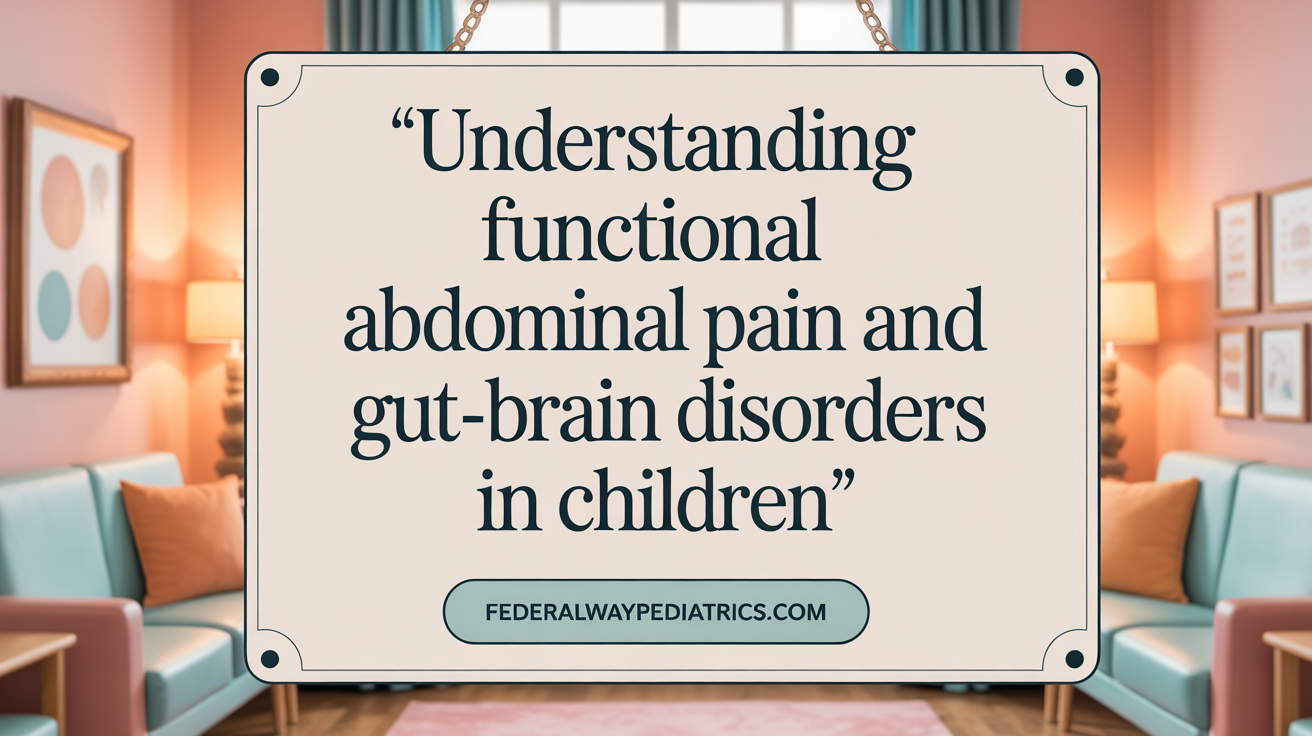A Complex Challenge in Pediatric Emergency Medicine
Recurrent abdominal pain (RAP) in children presents a common yet complex challenge in pediatric emergency rooms worldwide. Defined by repeated episodes of pain over at least three months that impede daily activities, RAP affects up to 20% of school-aged children, accounting for a significant proportion of primary care and emergency visits. This article unpacks the multifaceted nature of RAP, focusing on its causes, diagnostic approach, clinical features, management, and the critical role of healthcare providers and caregivers in optimizing outcomes for pediatric patients presenting with abdominal pain in emergency settings.
Common Causes and Clinical Features of Recurrent Abdominal Pain in Children
Recurrent abdominal pain (RAP) in children is a frequent complaint, affecting approximately 10-20% of the pediatric population at some point. It is defined as episodes of pain occurring at least three times over a period of more than three months that interfere with normal daily activities. Most cases of RAP are attributed to functional gastrointestinal disorders, such as functional abdominal pain or irritable bowel syndrome, where no identifiable structural or biochemical abnormalities are detected. These functional causes are characterized by episodic pain that lacks a clear organic origin and often improves with age or reassurance.
Organic causes of RAP are less common, found in about 5% to 10% of cases. Conditions such as constipation, Crohn's disease, celiac disease, lactose intolerance, and infections like Giardia are examples that may have identifiable signs or laboratory findings. Alarm symptoms suggesting an organic cause include persistent vomiting, blood in stool, unexplained weight loss, fever, or systemic signs, guiding the need for targeted diagnostic testing.
Symptoms associated with recurrent abdominal pain vary according to the underlying cause. In functional disorders, pain episodes are typically unpredictable, with children reporting episodes of diffuse or poorly localized pain that may wake them from sleep and last less than an hour. Other common features include changes in bowel habits, such as constipation or diarrhea, and visceral hypersensitivity. Children may also experience symptoms like nausea, headach, or fatigue.
Psychological factors play a significant role in RAP, particularly in functional cases. Stress, anxiety, or emotional disturbances can trigger or worsen the episodes, though these do not directly cause the pain. Importantly, these functional pains are generally benign, and management aims to reassure families, address psychological components, and support normal routines.
| Causes of RAP | Typical Features | Diagnostic Clues |
|---|---|---|
| Functional gastrointestinal disorders | Episodic, diffuse, no structural pathology | No alarm symptoms, normal physical exam |
| Organic causes | May involve systemic symptoms or abnormal signs | Fever, blood in stool, weight loss, abnormal labs |
| Other causes | Specific symptoms depending on condition | Constipation, diarrhea, vomiting |
Diagnostic Approaches and Evaluation in Pediatric Recurrent Abdominal Pain

What diagnostic approaches and evaluation procedures are recommended for recurrent abdominal pain in children?
Evaluating recurrent abdominal pain (RAP) in children involves a systematic process that combines detailed history-taking, physical examination, and targeted testing. The initial step is to obtain a comprehensive history, focusing on the pattern, duration, intensity, and location of pain, along with associated symptoms such as nausea, vomiting, diarrhea, or blood in stool. The physical exam aims to detect signs suggestive of organic disease, including tenderness, palpable masses, or abnormal neurological findings.
A crucial part of this assessment is identifying alarm symptoms that may indicate a serious underlying condition. These symptoms include fever, unexplained weight loss, persistent vomiting, blood in stool, night-time diarrhea, and signs of systemic illness or growth failure.
Based on clinical findings, healthcare providers may request laboratory investigations such as complete blood count (CBC) to assess for anemia or infection, inflammatory markers like erythrocyte sedimentation rate (ESR) or C-reactive protein (CRP) for inflammation, urinalysis to rule out urinary causes, and specific serology tests including celiac disease screening.
Imaging studies, most notably abdominal ultrasound, are often employed as the first-line modality to evaluate suspected conditions like appendicitis, intussusception, or ovarian pathology. Endoscopy or contrast studies are considered when indicated by specific symptoms or abnormal test findings.
In many cases, especially if no alarm symptoms are present and physical exam is normal, the diagnosis of functional abdominal pain can be made clinically without extensive testing. This approach emphasizes reassurance, education, and psychosocial support, reserving invasive procedures for scenarios where organic causes are strongly suspected.
A personalized evaluation strategy that integrates clinical findings with appropriate tests ensures accurate diagnosis and effective management.
What guidelines and clinical practices are recommended for the assessment of pediatric abdominal pain?
Clinical guidelines advocate a structured approach to pediatric abdominal pain, prioritizing safety and avoiding unnecessary investigations. They recommend starting with a detailed history and physical examination focused on identifying features indicative of urgent surgical causes, such as rebound tenderness, guarding, pain localization, and systemic signs like fever or weight loss.
Initial investigations should include basic laboratory tests: CBC, ESR or CRP to detect inflammation, urinalysis, and pregnancy tests in applicable age groups. Abdominal ultrasound is the imaging modality of choice because it is non-invasive, lacks radiation exposure, and effectively evaluates common surgical causes like appendicitis, ovarian torsion, or intussusception.
Imaging with computed tomography (CT) scans is reserved for cases where ultrasound is inconclusive and further anatomical detail is necessary, but it should be used judiciously to minimize radiation exposure.
Careful differentiation between urgent surgical emergencies and benign functional disorders guides subsequent management. Children with alarm features or abnormal lab results require prompt referral and further investigation, while those without findings can often be managed conservatively with reassurance and close follow-up.
Persistent or worsening symptoms warrant re-evaluation, and clinicians should base decisions on evolving clinical suspicion. Overall, adherence to these guidelines ensures timely diagnosis, avoids unnecessary tests, and promotes appropriate treatment strategies tailored to each child's presentation.
Red Flags and Differentiation of Benign Versus Serious Causes

What are the red flags and warning signs that indicate serious pathology in pediatric recurrent abdominal pain?
Red flags in children with recurrent abdominal pain signal the possibility of serious underlying conditions that require prompt evaluation. These signs include persistent fever, unintentional weight loss, growth retardation, and pain that interrupts sleep. Physical examination findings such as abdominal tenderness, masses, rebound tenderness, and signs of peritonitis are particularly concerning. Laboratory markers like elevated ESR or CRP indicate systemic inflammation. Additional alarm features include persistent vomiting, blood in stool or vomit, and delayed puberty. A family history of gastrointestinal conditions like Crohn's disease, celiac disease, or peptic ulcers further heightens suspicion. When these red flags are present, clinicians should act swiftly, considering referral for advanced testing to identify conditions such as inflammatory bowel disease, gastrointestinal malignancies, or structural anomalies, ensuring timely management.
How can healthcare providers differentiate between benign and serious causes of recurrent abdominal pain in children?
Diligent clinical evaluation is vital for distinguishing benign from serious causes of recurrent abdominal pain. A detailed history focusing on pain characteristics—such as location, duration, and triggers—along with a thorough physical exam, guides initial assessment. Features pointing toward serious causes include localized pain, signs of peritonitis, systemic symptoms like fever and weight loss, and laboratory abnormalities like anemia or elevated inflammatory markers. Diagnostic imaging, primarily ultrasound, plays a crucial role in detecting surgical emergencies like appendicitis, intussusception, or malrotation. Blood tests can reveal inflammatory or systemic diseases. Most recurrent pain, especially in the absence of alarm signs, is functional, often linked to gut-brain axis disorders. Continuous vigilance helps prevent missed diagnoses, enabling timely intervention for organic diseases while avoiding unnecessary procedures in benign cases.
Management and Treatment Strategies in the Pediatric Emergency Setting

What management and treatment strategies are effective for recurrent abdominal pain in pediatric patients, including emergency care?
Effective handling of recurrent abdominal pain (RAP) in children, especially in emergency situations, requires a systematic approach. Initially, healthcare providers should conduct a thorough evaluation, including detailed history-taking and physical examination, to distinguish between benign causes and potentially serious, urgent conditions.
In acute settings, urgent assessment aims at identifying alarm signs such as severe pain, signs of peritonitis, or systemic symptoms like fever or shock. Laboratory tests such as complete blood count, inflammatory markers, urinalysis, and targeted imaging—primarily ultrasonography—assist in diagnosing conditions like appendicitis, bowel obstruction, or urinary tract infections.
Stabilization is crucial for children with signs of dehydration or severe pain. This involves administering IV fluids to maintain hydration, providing pain relief with medication like paracetamol or opioids when appropriate, and ensuring close monitoring.
In cases where organic causes such as appendicitis or bowel obstruction are identified, prompt surgical consultation and intervention are necessary. Ensuring quick access to surgical care can prevent complications.
For non-surgical or presumed functional causes, management focuses on symptomatic relief, reassurance, and addressing underlying factors. Dietary modifications, psychological support, and education help manage symptoms and reduce anxiety.
Psychological and behavioral therapies like cognitive behavioral therapy (CBT) and hypnotherapy have proven beneficial for functional pain, often leading to significant or sustained symptom improvement.
In the emergency context, rapid stabilization and careful re-evaluation are vital — especially when symptoms evolve or clinical signs suggest worsening. This approach helps prevent complications and guides optimal treatment pathways.
Most importantly, care must be tailored to each child's specific presentation. Close follow-up after discharge ensures ongoing management, symptom monitoring, and support.
In summary, pediatric RAP management in emergency settings emphasizes swift assessment, stabilization, targeted treatment, and individualized care based on diagnostic findings and urgency of the condition.
Common and Differential Diagnoses in Pediatric Recurrent Abdominal Pain
Recurrent or chronic abdominal pain in children involves a broad spectrum of potential causes, spanning from functional gastrointestinal disorders to specific organic diseases.
Functional gastrointestinal disorders, including disorders of gut-brain interaction (DGBIs), such as irritable bowel syndrome and functional abdominal pain, are the most prevalent. These conditions typically present with pain that is not localized, lacks clear association with food intake or activity, and often coexists with psychological factors like stress or anxiety. Despite significant discomfort, children with DGBIs generally have normal test results.
On the other hand, organic causes are less common but crucial to identify. These include gastrointestinal inflammatory conditions like inflammatory bowel disease, infections such as urinary tract infections, metabolic disorders like celiac disease or lactose intolerance, and surgical conditions such as appendicitis or Meckel diverticulum. Signs pointing toward organic diseases include weight loss, persistent vomiting, blood in stool, or systemic symptoms such as fever.
Age-related factors influence the differential diagnosis. In infants and toddlers, causes like intussusception or hernias dominate, while in older children and adolescents, conditions like appendicitis, ovarian torsion, or gastrointestinal tumors become more relevant.
Diagnosis relies heavily on detailed history-taking and physical examinations to identify alarm symptoms or red flags. When risk factors or signs of organic disease are present, targeted laboratory tests, imaging, or endoscopy may be indicated. However, many cases labeled as functional are managed with reassurance and psychosocial support, emphasizing the importance of tailored diagnostic suspicion based on the child's age, symptoms, and clinical presentation.
In summary, careful differentiation between functional and organic causes ensures appropriate management, minimizes unnecessary testing, and improves patient outcomes in pediatric recurrent abdominal pain.
Role of Healthcare Providers and Caregivers in the Evaluation and Management

What roles do healthcare providers and caregivers play in evaluating and managing recurrent abdominal pain in children?
Healthcare providers are fundamental in diagnosing recurrent abdominal pain (RAP) by thoroughly assessing the child's clinical history and physical examination. They determine whether alarm symptoms, such as weight loss, blood in stool, or persistent vomiting, are present, which may indicate underlying organic causes requiring specialized testing or referral.
In cases without red flags, providers often rely on a clinical diagnosis of functional abdominal pain, emphasizing reassurance and education. They adopt a biopsychosocial approach, involving a multidisciplinary team—including pediatric gastroenterologists, dietitians, psychologists, and physical therapists—to design and implement comprehensive management plans.
Psychological assessment is a vital component. Identifying factors like anxiety or depression helps tailor therapies such as cognitive-behavioral therapy (CBT) or hypnotherapy, which have proven effective in alleviating symptoms.
Caregivers are key partners throughout this process. They support dietary adjustments, encourage participation in behavioral therapies, and help implement coping strategies at home. Family involvement enhances treatment adherence and emotional support, creating a nurturing environment that addresses not only the child's symptoms but also familial dynamics.
In summary, managing pediatric RAP effectively hinges on coordinated efforts between healthcare teams and families. Such collaboration ensures a holistic approach that considers biological factors, mental health, and social environment, ultimately improving the child's quality of life and reducing disability associated with chronic pain.
Understanding Functional Abdominal Pain and Disorders of Gut-Brain Interaction

Definition and epidemiology of functional abdominal pain
Functional abdominal pain (FAP) in children is defined by recurring episodes of tummy pain occurring at least three times over a three-month period, interfering with daily routines. It is one of the most common causes of recurrent abdominal pain (RAP), affecting roughly 13.5% of children worldwide. While organic causes are identified in only 5% to 10% of cases, the majority are considered functional, meaning no structural or biochemical abnormalities are found.
Mechanisms involving gut-brain axis and visceral hypersensitivity
The underlying mechanism of FAP involves complex interactions between the gut and brain, often referred to as disorders of gut-brain interaction. These disorders can cause visceral hypersensitivity, where children experience increased sensitivity to normal gut stimuli. Other contributing factors include altered gut motility, changes in intestinal microbiota, immune response, and neurotransmitter activity, all disrupting normal gut function.
Psychosocial contributors and symptom manifestation
Psychosocial factors such as stress, anxiety, depression, family dynamics, and bullying can worsen symptoms or contribute to the development of functional abdominal pain. Children may report symptoms like nausea, bloating, and irregular bowel habits, often with elevated distress. These factors create a cycle where psychological stress worsens physical symptoms, which in turn increases anxiety.
Diagnostic criteria and typical clinical course
Diagnosis is primarily clinical, based on Rome IV criteria, which emphasize recurrent pain lasting at least two months without evidence of organic disease. Red flags like weight loss, GI bleeding, or systemic symptoms suggest organic causes and warrant further investigation. Most children improve over time with reassurance and appropriate management. The pain is usually not linked to any visible or biochemical abnormality, and test results are typically normal.
Evidence-based treatment modalities and outcomes
Management emphasizes reassurance, education, and a multidisciplinary approach. Psychological therapies such as cognitive behavioral therapy (CBT), hypnotherapy, and relaxation techniques have proven effective. Medications like antispasmodics or low-dose antidepressants are sometimes used, but psychological interventions remain central. Most children respond well, with many experiencing significant symptom relief and improved quality of life.
| Aspect | Description | Additional Notes |
|---|---|---|
| Prevalence | ~13.5% worldwide | Most cases are functional without organic findings |
| Typical symptoms | Abdominal pain, nausea, bloating | Often linked with psychosocial stress |
| Diagnosis | Based on Rome IV criteria | No specific tests required in uncomplicated cases |
| Treatments | Reassurance, CBT, hypnotherapy | Focus on coping, reducing distress |
| Prognosis | Generally good | Many improve without medication |
Integrating Clinical Insight and Compassion in Pediatric Abdominal Pain
Recurrent abdominal pain in the pediatric emergency setting represents a diagnostic and therapeutic challenge that demands a careful, evidence-based approach. Recognizing that the majority of cases are functional in nature while systematically identifying red flags for serious disease allows healthcare providers to tailor evaluation and management appropriately. The integration of clinical skills, multidisciplinary collaboration, and compassionate communication with families fosters better outcomes by addressing the biological, psychological, and social dimensions of pain. Ultimately, timely diagnosis, reassurance, individualized treatment plans, and ongoing support ensure that children with recurrent abdominal pain receive effective care that minimizes disability and enhances quality of life.
References
- Recurrent Abdominal Pain in Children - AAFP
- Recurrent abdominal pain in children: a clinical approach - PMC
- Chronic abdominal pain in children and adolescents (Beyond the ...
- Chronic Abdominal Pain | Children's Hospital Colorado
- Acute Abdominal Pain in Children - AAFP
- Chronic Abdominal Pain in Children | American Academy of Pediatrics
- Functional Abdominal Pain in Children - Seattle Children's Hospital
